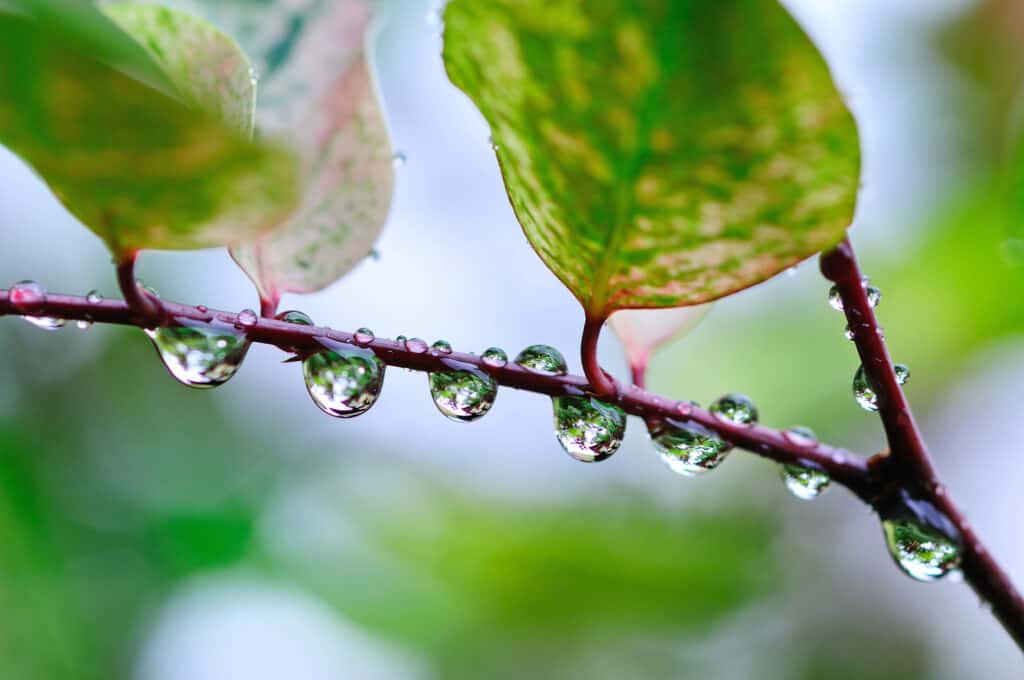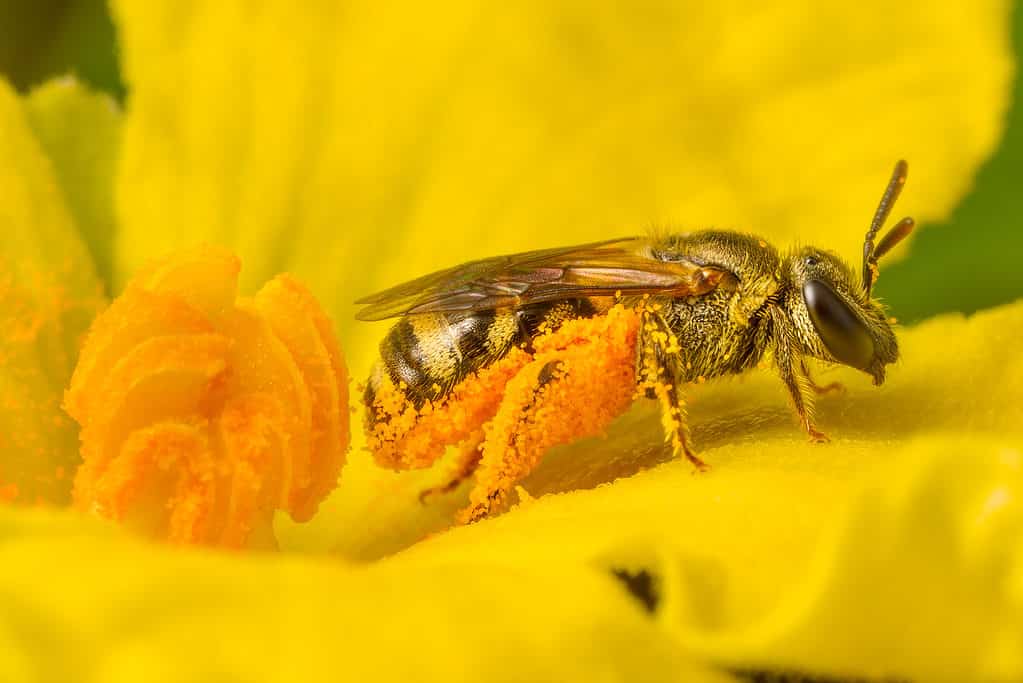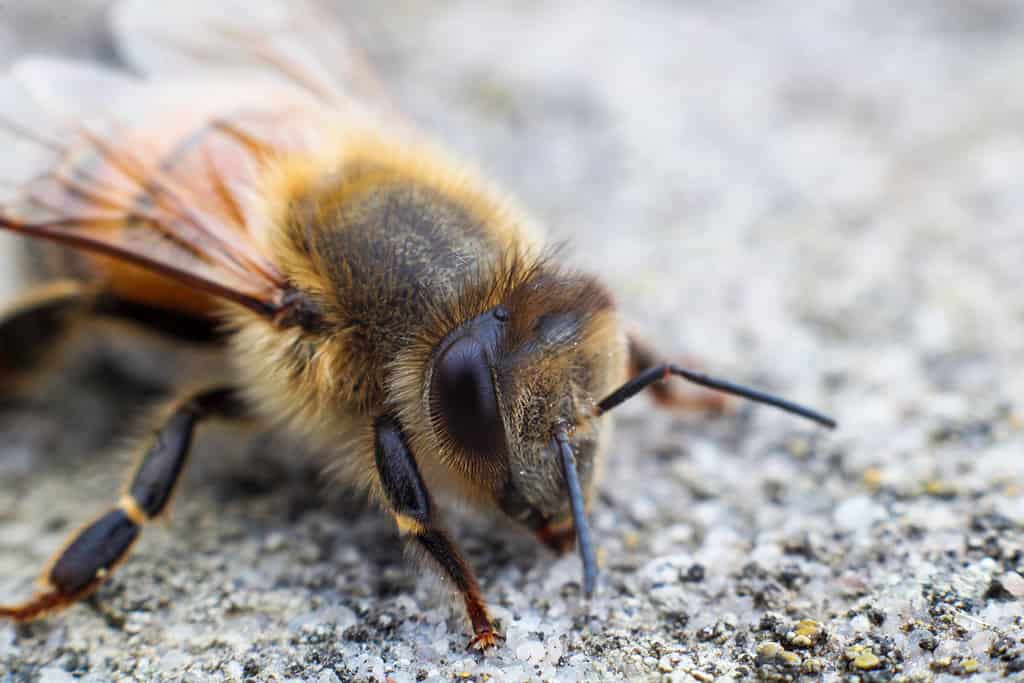When raindrops start steadily beating on the ground, you may notice the absence of bees buzzing around. Ever wonder where bees go when it rains? Or how they know when to retreat? The answer to these questions reveals bees have unique sensory systems and high intelligence.

Raindrops can be as big as a bee’s body, making it risky for them to fly in a storm.
©iStock.com/Damon_Moss
Can Bees Fly in Rain?
Bees can fly in light rain but generally avoid rainy weather for several reasons. Large raindrops can knock bees to the ground and injure them. But even a light, misty rain can be dangerous for bees. Water accumulates on their body, making it difficult for their wings to work correctly — which generally beat 12,000 times per minute.
Bees retreat to safe, sheltered locations rather than lose their ability to navigate or risk flying through large raindrops. They seek out their favorite safe havens when the weather is rainy, but some of their nesting habits may surprise you.
Bees Predict Weather
Bees are nature’s fuzzy weather forecasters. Expert beekeeper and author Howland Blackiston explains, “Bees are able to sense barometric pressure changes, helping them predict when storms are coming. When they sense an incoming storm, they collect pollen to eat because they know they won’t be able to harvest it during the storm.”

Bees collect more pollen when they sense atmospheric changes that indicate rain.
©kajornyot wildlife photography/Shutterstock.com
In a study by Jiangxi Agricultural University in China, researchers tagged bees with RFID technology. They observed bees preparing for oncoming storms by staying out longer and gathering more pollen in the days just before rainy weather hit.
How Bees Navigate
Bees have eyesight that rivals humans and many other animals. Not only do bees see patterns and light waves that we can’t perceive, but they can also see small details while flying at high speeds. Seeing patterns while flying is a big part of how bees navigate.
If you have ever swatted at a bee, you may know that they are experts at dodging moving objects. Bees can see three dimensions and perceive depth while flying. In fact, bees see the best while in flight!
Bees can see beyond the spectrum of color humans can see. They see ultraviolet light, including patterns from nectar on flowers. Bees use their keen eyesight to navigate their environment, quickly learning differences in color, shapes, and fragrances. They use the patterns they see as landmarks for returning home.

Bees can see polarized light, which makes patterns in the sky that bees use to navigate.
©Leestudio/Shutterstock.com
Bees use the sun as a compass to navigate. Polarized light makes a pattern in the sky that bees can detect but is invisible to us. If there is a patch of clear sky, bees can figure out where the sun is even when it is behind clouds. However, if storm clouds cover the sky completely, bees lose their ability to navigate.
You might wonder if bees can fly at night since they use light to navigate. Interestingly, a few bee species can fly at night, but honeybees and bumblebees cannot navigate in the dark.
Where Bees Go When It Rains
Where bees go when it rains varies between species. When you picture a bee, you might imagine a stripped honeybee living in a honeycomb hive. However, an estimated 20,000 different bee species are classified into seven types of bees.
Types of Bees
The seven bee families can be classified into three broad groups based on the average length of their tongue, called a proboscis. Long-tongued bees use their proboscis to drink nectar from deep floral chambers, unlike short-tongued bees, who forage for pollen and drink from flowers with short chambers.
Bumblebees, mason bees, carpenter bees, and honeybees are commonly found in gardens and natural areas. Most bee species do not live in hives but make nests on their own or in small groups. Each type of bee has a different nesting habit, affecting where they shelter when it rains. Some bees retreat to their hives, while others seek shelter in nests or burrows.

Most wild bees are solitary and live in burrows, hollow stems, and other nesting locations, not hives.
©IanRedding/Shutterstock.com
Bees make their home in a variety of places and are incredibly adaptable. Different bee species can be found anywhere from high up in a tree to underground tunnels. Here’s a look at the diversity of bee nesting habits, and the most common places bees go when it rains.
Where Bees Take Refuge
- Bumblebees tend to nest in the ground, either in abandoned holes or crevices near trees. They might also nest in man-made containers near houses. They return to their home base if they sense rain.
- Honeybees live in hives, which they return to when rainy weather is imminent. They often work hard before a rainstorm to plug up crevices in the hive with propolis, a resin-like substance bees collect from tree buds.
- Carpenter bees create tunnels by chewing into wood. They retreat to their tunnels when it rains.
- Ground-nesting bees, or miner bees, make burrows in the ground. They return to their holes during rainstorms.
- Mason bees make nests in all kinds of creative spaces. They might nest in a hollow plant stem, a hollow cane, dried leaves, and even abandoned snail shells!
Bees Stranded in Sudden Storms
Even though bees are experts at predicting the weather, they sometimes get caught in an unexpected storm or abrupt temperature change. Bees take refuge in trees, bushes, or flowers when this happens. They position themselves on the underside of a leaf or petal so that most of the rain runs off the top side of the foliage, keeping them as dry as possible.

Bees shelter on the underside of leaves or petals when they are caught in heavy rain.
©HWall/Shutterstock.com
You might have noticed bees aren’t active in cold weather. Bees know when it is time to prepare for seasonal cold periods. Bees are most active during warm seasons like spring, summer, and fall. They follow the blooming patterns of their climate, gathering pollen and nectar from flowering plants. When temperatures start dropping in the fall, bees are prompted to prepare for hibernation. Where bees go in the winter depends on the type of bee and where they live. Some bees spend winters in a hive, while others spend winter in underground burrows or nests.
How to Help a Rain-Soaked Bee
Sometimes, sudden weather changes and cold temperatures combine to create a dangerous environment for bees. While bees usually find a leaf or petal to take cover under and recover quickly from a rain shower, there are certain times of the year when a storm can leave them wet, cold, and stranded. Bee experts suggest evaluating the situation before helping a wet bee. Bees sheltering under petals or leaves most likely do not need help unless the temperature is below 55 °F (13 °C).

A bee resting on the ground is not in danger unless it is stuck in heavy rain or cold temperatures.
©iStock.com/D-Steinmeyer
When you come across a sluggish, wet bee on the ground after a rainstorm, it may just be drying itself. If the sun is out and other bees are buzzing around nearby flowers, you can help the grounded bee by scooping it onto a large leaf and depositing it on a flower. Bees need to replenish their energy with nectar every 45 minutes.
If you encounter a lethargic bee exposed to heavy rain or cold temperatures, you can scoop it up in a leaf and put it in a shoebox. A garage or carport often provides enough warmth for the bee. If it’s still daytime, offer the bee some sugar water in a shallow dish such as a bottle cap. The best mixture is made using white sugar with water at a 50/50 ratio. Remove the container at night so the bee does not get stuck in the liquid. The warmth and sugar water will help the bee recover after one or two nights. Then, when the weather is dry and warm, you can release the bee where you found it.
Bee Habitat Protection
Native bee species and domesticated honeybee populations are declining. One of the main threats to bees is the loss of essential habitat. Bees are incredibly resilient but need natural areas to find food sources and build nests.
There are easy ways to get involved with bee habitat conservation — and most don’t require a lot of space! Here’s a list of simple actions you can take to help bees find safe places to call home.
- Purchase native plants when you add plants to your yard or patio. It will help wild bee species that feed exclusively from native flowers.
- Plant a flowering tree like native maples or cherry species. Trees are an excellent food source, providing resin and leaves for nesting material, and crevices for burrows.
- Leave a bare patch of soil in your garden. Ground-nesting bees overwinter underground with their babies.
- Leave hollow plant stems in your garden until spring. Many bee species create cozy homes for winter in hollow stems.
- Avoid using chemicals such as the ones commonly found in pesticides, herbicides, and fertilizers. Opt for an organic bee-safe product instead.
As pollinators, bees are critical to the survival of native plants, food crops, wildlife, and humans. Individuals can significantly impact global efforts to restore bee habitats for the bees working in nearly every ecosystem around the world.
The photo featured at the top of this post is © HWall/Shutterstock.com
Thank you for reading! Have some feedback for us? Contact the AZ Animals editorial team.







